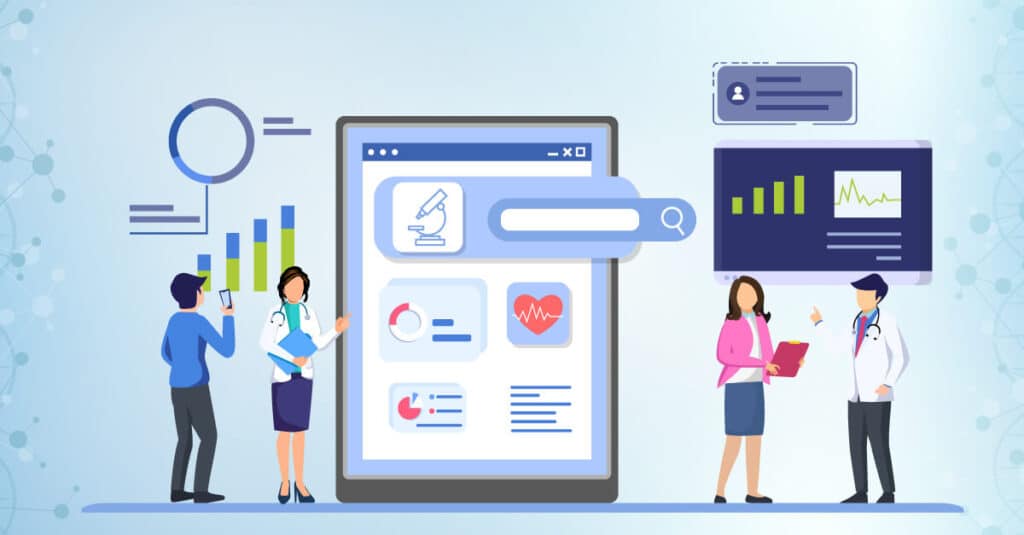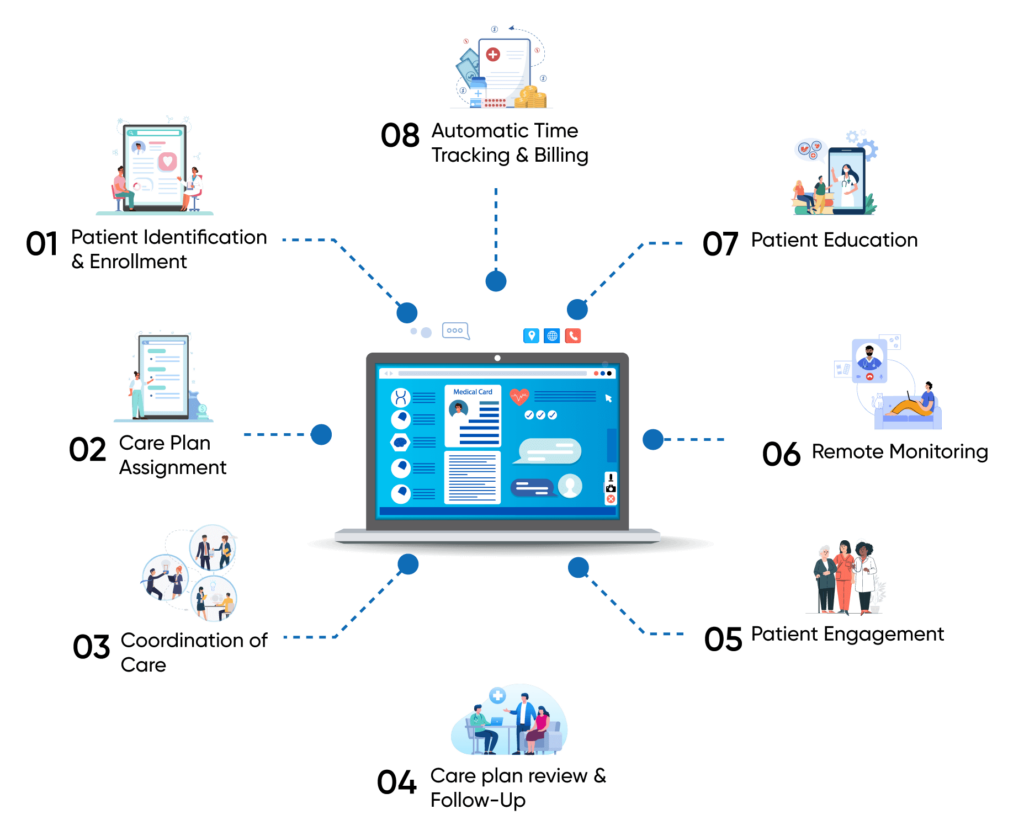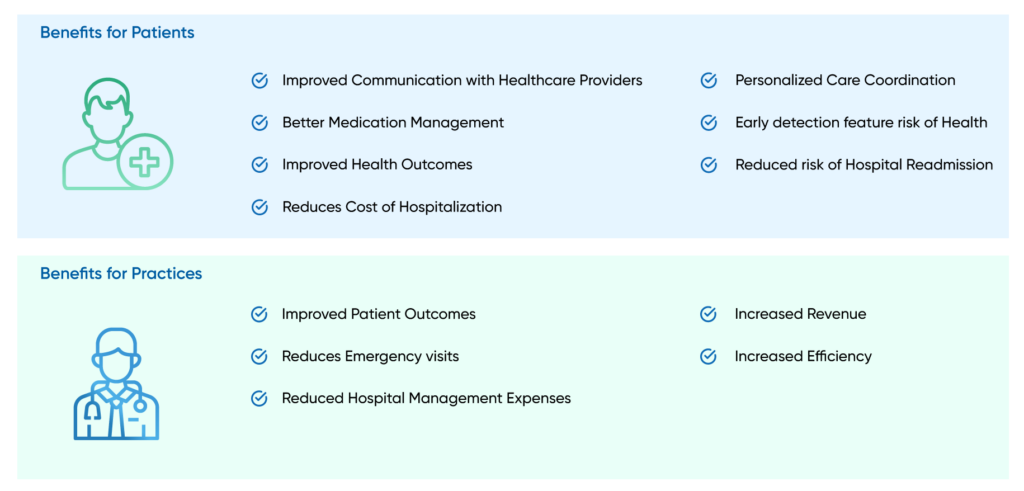What is Chronic Care Management Software?

Chronic care management software is an innovative tool. It helps healthcare providers improve patient outcomes. This is done by providing more personalized and efficient care to patients with chronic conditions. Furthermore, this software helps providers manage patient data, track progress, and coordinate care across multiple providers.
Chronic care management software can assist providers in recognizing patients prone to developing chronic conditions. It can also monitor patients’ symptoms and medical history. Moreover, it can provide ongoing care management to ensure patients get the proper care they need to manage their conditions.
Some of the key features of chronic care management software must include the following:
- Patient Data Management: Basically, Chronic care management software allows providers to collect, organize, and manage patient data in a centralized location. This makes it easy for providers to access patient records, track medical history, and monitor patient progress altogether.
- Care plan management and coordination: Chronic care management software facilitates care plan management and coordination. This then ensures provider communication and coordination, allowing seamless care across multiple settings. This can include alerts and notifications to providers when patients are admitted to the hospital or receive emergency care.
- Patient Education and Engagement: Chronic care management software can also help patients manage their conditions. It does this by providing them with educational materials and resources. This enables them to become more engaged with their health. Providers can also use the software to communicate with patients directly, providing guidance, support, and encouragement.
- Automated time tracking and Billing: Chronic care management software can simplify billing processes. This technology can track how much time providers spend with each patient. It can also submit claims for services given to those with chronic illnesses. In addition, this can help providers save time and resources.
How Chronic Care Management Software Works?

CCM software is designed to achieve three goals, Improve patient outcomes. Reduce healthcare costs. Enhance the quality of care for patients with chronic conditions. Here’s how chronic care management software works:
1. Patient identification and enrollment
Providers can create a patient profile and collect clinical details in chronic care management software. The chronic conditions system will determine if the patient is eligible for CCM services. The provider must then sign a consent form to officially enroll the patient in CCM services.
2. Care Plan Assignment
After the enrollment of the patients, providers can then create a care plan for them. This plan should take into account their chronic conditions and lifestyle. Accordingly, the care plan outlines the patient’s treatment goals, services, and healthcare providers involved in the patient’s care.
3. Coordination of Care
Chronic care management involves coordinating care across multiple healthcare providers and settings. Primary care providers, specialists, and other healthcare providers can communicate from time to time. This helps ensure that patients receive the care they need.
4. Care plan review and Follow-Up
Patients are monitored regularly. This helps to track the care plan and its progress. It also ensures they receive the necessary care if a required provider can update care plan elements.
5. Patient engagement
Patient engagement is improved through the use of software. It enables communication between patients and providers in various ways, such as phone calls, video calls, and two-way messaging. In addition, timely alerts, notifications, and reminders make the patient more compliant to adhere to care plan instructions. Patients can also use the software to communicate with their care team, track their health data, and view their care plans.
6. Remote monitoring
Remote monitoring is possible with this software. To rephrase it providers can track patients’ health remotely using connected devices. Examples include blood pressure monitors, glucose meters, and activity trackers. Providers can receive alerts and notifications when patients’ health status changes.
7. Patient Education
Chronic care management software involves patient education and empowerment features. Patients receive education and resources. This helps them understand their condition. It also assists them in managing symptoms and making informed decisions about their healthcare.
8. Automatic Time Tracking and Billing
Every chronic care management software must be able to track providers’ time spent on each patient. The First thing to remember, is that Insurance companies and Medicare typically reimburse chronic care management services for time logged by the provider. So Providers must document and bill for CCM services provided to patients with chronic conditions.
What benefits of Chronic care management software?

Benefits for patient
- Improved communication with healthcare providers
- Personalized care coordination
- Better medication management
- Early detection features risk of health
- Improved health outcomes
- Reduced risk of hospital readmission
- Reduces cost of hospitalization
Benefits for Practices
- Improved patient outcomes
- Increased revenue
- Reduces Emergency visits
- Increased efficiency
- Reduced hospital management expenses
Chronic Care Management Market & Its Trends
Diseases, such as diabetes, heart disease, and cancer, are among the leading causes of death globally. Chronic care management is generally a healthcare model. Its goal is to give continuous care to patients with chronic diseases. This also helps them manage their conditions and improve their health.
The chronic care management market has seen a sharp growth in recent years. This is mainly due to several different factors. An ageing population is increasing the demand for healthcare services, as seniors require more frequent and specialized care.
The prevalence of chronic diseases is increasing. Approximately 3 out of 5 adults in the United States have at least one chronic health condition. Furthermore, this has resulted in an increased need for chronic care management, driving the market’s growth. Hence the adoption of healthcare IT solutions is increasing.
Organizations are implementing technology-enabled care management solutions to enhance patient outcomes and lower costs. The chronic care management market has benefited from this. Providers can now deliver quality care with greater ease.
Market Size and Growth
The worldwide chronic care management industry is estimated to expand significantly. Market Research Future (MRFR) reported that 2021 was valued at USD 4.69 billion. By 2030, the industry is projected to reach USD 15.82 billion. This growth is anticipated to have a compound annual growth rate of 13.82% from 2022 to 2030.
Chronic diseases are becoming more common. Healthcare costs are increasing. Value-based care models are being adopted more often. These factors are driving the market growth.
Technology Trends
Adopting healthcare IT solutions such as electronic health records (EHRs), patient portals, and telemedicine platforms has been a significant trend in chronic care management. These technologies enable healthcare providers to improve patient communication and collaboration, enhance care coordination, and provide personalized care.
For example, telemedicine platforms enable providers to remotely monitor patients’ vital signs and symptoms, provide virtual consultations, and offer medication management services. Patient portals allow patients to access their health records, communicate with their healthcare providers, and schedule appointments conveniently.
The increasing use of wearables and remote patient monitoring (RPM) devices is another trend in the chronic care management market. These devices enable patients to monitor their health status in real-time and share the data with their healthcare providers for timely interventions. RPM devices can also help reduce hospital readmissions and emergency department visits by enabling early detection and management of chronic disease exacerbations.
Regulatory Landscape
The Centers for Medicare and Medicaid Services (CMS) introduced the Chronic Care Management (CCM) program in 2015 to encourage healthcare providers to provide ongoing care to Medicare beneficiaries with two or more chronic conditions. The program provides reimbursement for non-face-to-face care management services, such as care coordination, medication management, and remote patient monitoring.
In 2020, CMS expanded the CCM program to include more services and simplify the billing process for providers. The agency also introduced new codes for top care management (PCM) and behavioural health integration (BHI) services, which provide reimbursement for care management services for patients with a single chronic or behavioural health condition.
Step By Step Process To Develop Custom Chronic Care Management Software

Chronic care management (CCM) is a critical aspect of healthcare that requires careful coordination between patients, their families, and healthcare providers. While many healthcare organizations use commercially available CCM software, others may find it necessary to develop custom software that meets their specific needs. This article outlines a step-by-step process for developing custom CCM software.
Step 1: Identify User Requirements
The first step in developing custom CCM software is identifying user requirements. These requirements should be gathered from all stakeholders, including healthcare providers, patients, and family members. User requirements should include a list of features necessary for managing chronic conditions effectively.
Step 2: Design the Software Architecture
After gathering user requirements, the next step is to design the software architecture. The architecture should support all the features required to manage chronic conditions effectively. This step may require consultation with software developers or architects with experience building healthcare software.
Step 3: Develop the User Interface
Once the software architecture has been designed, the next step is to develop the user interface. The user interface should be intuitive and easy to use, even for patients who may need to be tech-savvy. It should also be designed to be accessible to people with disabilities.
Step 4: Develop the Software Functionality
After the user interface has been developed, the next step is to develop the software functionality. The software should be developed to support all the features identified in the user requirements. This may include patient scheduling, medication management, and remote monitoring.
Step 5: Test the Software
Once the software has been developed, the next step is to test it. The software should be tested to ensure it meets all user requirements and functions correctly. This step may require the help of a software testing team or third-party testing service.
Step 6: Deploy the Software
After the software has been tested and any issues have been addressed, the next step is to deploy it. The deployment of the software should be in a controlled environment to ensure it is stable and does not negatively impact patient care. However, this may require consultation with healthcare providers or IT staff.
Step 7: Provide Maintenance and Support
After the deployment of the software, then, the next step is to provide training and support to healthcare providers, patients, and family members. This may include providing user manuals, hosting training sessions, and providing technical support. Ongoing support and maintenance should also be provided to ensure the software continues functioning correctly over time.
How Much Does Chronic Care Management Software Cost?
There are a few factors to consider regarding the cost of chronic care management software. Here are some of the critical factors that can influence the cost of CCM software:
- Features: The cost of CCM software can vary depending on its features. Some software may only provide basic features, while others may have more advanced features like patient portals, scheduling tools, and analytics.
- Integration: If the CCM software needs integration with other systems, such as electronic health records (EHRs), then this can increase the cost of implementation.
- User licenses: CCM software may be priced per user license. The more users need access to the software, the higher the cost.
Why Choose Thinkitive For Custom Chronic Care Management Software Development
In recent years, chronic care management has become essential to healthcare. Chronic diseases are stable health conditions requiring continuous medical attention, and managing them can be complex and challenging. That’s where custom chronic care management software comes into play.
Thinkitive is a leading software development company specializing in custom chronic care management software.
1. Experience and expertise
Thinkitive has years of experience in software development with a team of skilled developers who are experts in developing custom software solutions. Furthermore, we have completed numerous global projects, including chronic care management software, for clients. With our experience and expertise, we provide customized solutions that meet your specific requirements.
2. Custom solutions
At Thinkitive, we know that each business is unique, and therefore, our software solutions meet their specific needs as per their requirements. We work closely with their clients to understand their business requirements and develop custom software solutions that meet those needs. This ensures our clients get software that fits their business needs instead of a one-size-fits-all solution.
3. Scalability
As your business grows, so do your software needs. We at Thinkitive develop scalable software solutions that adapt to your changing business requirements. In addition, we ensure your software can handle more data, users, and features as your business expands.
4. Security
Regarding chronic care management, data security is of utmost importance. We follow the latest industry standards and guidelines to ensure our software solutions are secure and compliant with industry regulations. Moreover, we implement robust security measures to protect your data against cyber threats.
5. Support and Maintenance
Thinkitive undoubtedly provides excellent support and maintenance services to ensure their clients’ software solutions are always running. Our team of experts is available 24/7 to provide technical support and resolve any issues that may arise. We also provide regular maintenance services to keep your software up-to-date and running smoothly.
Conclusion
In conclusion, chronic care management software revolutionizes healthcare by enhancing patient outcomes and reducing costs. Its benefits, including improved communication, personalized care coordination, and early detection, transform healthcare delivery. At this point, the growing chronic care management market reflects the increasing demand for these solutions. Especially, the industry is also ready for substantial growth with technology trends like telemedicine and remote monitoring. However, developing custom CCM software requires careful planning, and choosing a trusted partner like Thinkitive which ensures a tailored, scalable, secure, and well-supported solution. Chronic care management software will improve patient care and healthcare efficiency as healthcare evolves.





There are lots of importance points of the chronic care management software are you mentioned in the article Nicely you explaining the working of the management software. It will be very useful content are you shared with us Thanks for shared this valuable content keep sharing